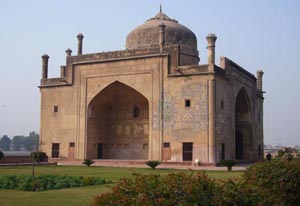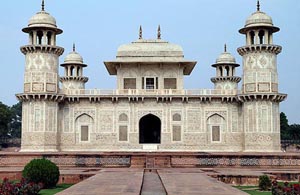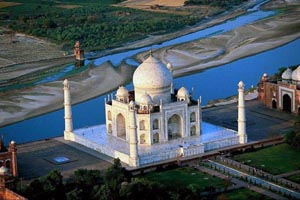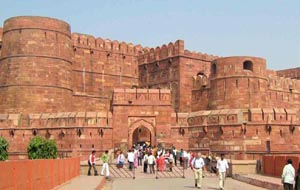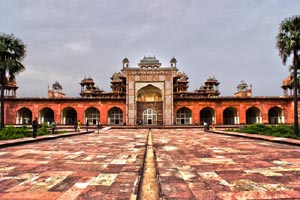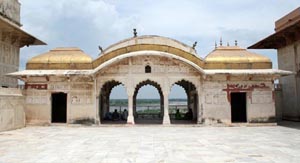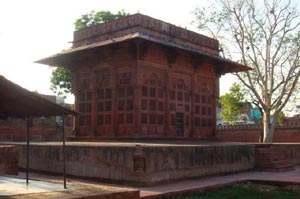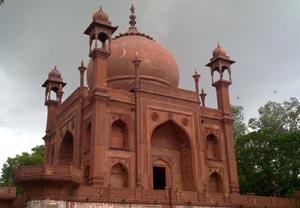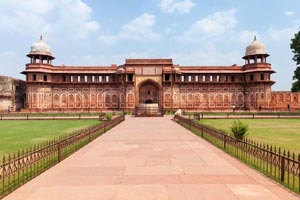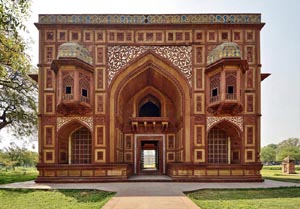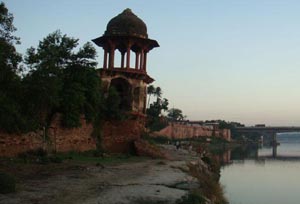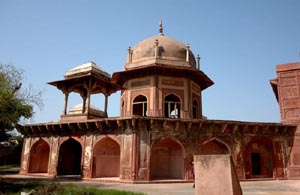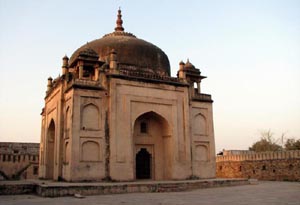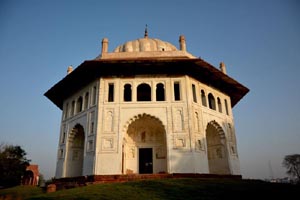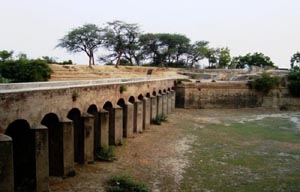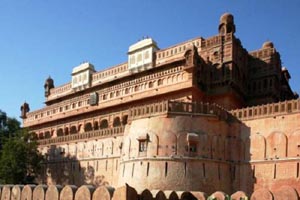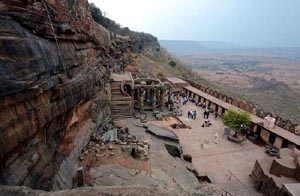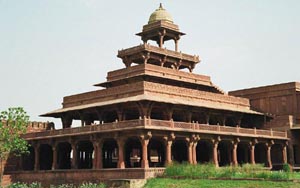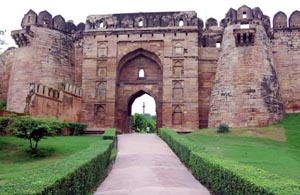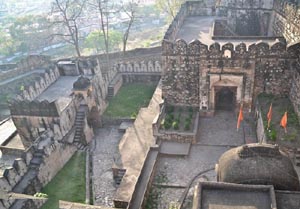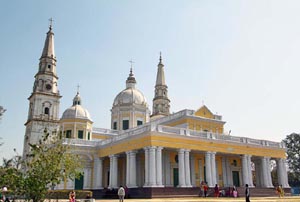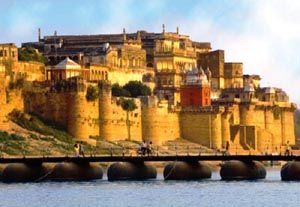Uttar Pradesh Monuments - Famous Historical Places, Forts & Palaces
List of names of Famous Historical Forts / Palaces / Places of Uttar Pradesh State
Here you can find list of names and information on historical forts / palaces/ places / monuments in Tamil Nadu, India. These famous monuments of Uttar Pradesh state are most visited and most sought after best tourist places. You can also find images of Uttar Pradesh monuments / places / forts / palaces.
Agra Monuments, Uttar Pradesh »
Chini Ka Rauza is considered to be one amongst the famous attractions of the tourists in Agra. The monument got its name from the glazing tiles which played a vital role in its construction, which were bought especially from China. The art work and the embellishments on the monument are just amazing and worth every visit. The tomb in the Chini Ka Rauza belongs to the then Prime Minister and poet of Shah Jahan, Allama Afzal Khan.
Itimad Ud Daulah was made in the memory of Mirza Ghyaz Ud Din or Ghyaz Beg by his beloved daughter, Noor Jahan. And so Ghyaz Beg later on came to be known as Itimad Ud Daulah. He was the Chief Minister or Wazir in the court of the King Jahangir. Noor Jahan was the wife of the Mughal Emperor Jahangir. She later became one of the powerful personalities of the Kingdom and so when her father died in the year 1622 she made a mausoleum for him which came to be known as Itimad Ud Daulah.
India is known to be a country that is rich in heritage and historically significant. The Mughal period, their architecture and monuments call for a compulsory mention when exploring the historical value of India. Historical monuments are considered to be an integral component of the country among which the Taj Mahal holds a place of intense connotation owing to its magnificent form of architecture.
Just 2.5 km away from the world famous monument, Taj Mahal is the red fort of Agra which is also known as the Agra Fort. An interesting fact about the Agra Fort is that it has got many fairy tale palaces in it like the Jahangir Palace and the Khas Mahal. It has also got breath-taking audience halls and two beautiful mosques which are truly a delight to every visitor. Visiting the Taj Mahal alone in Agra is said to be incomplete without a visit to the Agra Fort.
Sikandra is one amongst the most famous attractions which is just 10 km away from the center city of Agra. It is the Mausoleum of the great emperor, Akbar the great. The monument seems to be a combination of different styles of themes, some of which resembles the art form of the Hindus, Muslims, Jain, Christians and Buddhists etc. The name of the monument is after a famous ruler Sikandar Lodi who was the ruler of Delhi during 1488-1517.
The Khas Mahal is one of the most famous monuments built by Shah Jahan. It was built around 1631-1640. The Khas Mahal was also known as the "Aramgah-i-Muqaddar". What add on to the beauty of this magnificent palace are the river and the Anguri Bagh which are present on the two ends of the palace. The Khas Mahal was actually made by Shah Jahan for his two daughters whose names are Jahanara and Roshanara.
Chhatri Rani Hada is also termed as 'Sati ka Chabutra' or 'Chhatri of Raja Jaswant Singh' or 'Jaswant ki Chhatri'. It is located in Rajwara of Balkeshwar on the banks of Yamuna river of Agra. Although the memorial is named according to Jaswant, it was not actually created to honour him; rather it was created for the memory of queen Hada, the wife of Rao Amar Singh Rathor.
Hessing's Tomb is a historical monument, created for the memory of royal John William Hessing. He was a Dutch colonel who passed away in the year 1803. This tomb was created for memorising him, by Ann Hessing, the wife of John William Hessing. Hessing's Tomb is located in Agra on 3.4 meter tall rectangular stage encompassing an underground compartment. Hessing's Tomb is also known as 'Red Taj' since, it is created by red sandstone.
Located in Agra of Uttar Pradesh, Jahangir Palace is a significant structure of popular 'Agra Fort'. In other words, it is the biggest fortress created inside Agra Fort. It was created by Mughal king Akbar for his favourite son Jahangir in order to provide him soothe and amenity. It is an exclusive addition and the largest residential building in Agra Fort, which is simply outstanding and noteworthy.
Kanch Mahal is a lovely Mughal memorial which is located near Akbar's Tomb at Sikandra in Uttar Pradesh. Initially, Kanch Mahal was served as a palace for royal women. Throughout the sovereignty of Jahangir, the memorial was also used as hunting lodge for royal people. Created between 1605 to 1619, Kanch Mahal is presently become a ruined place and is administered by the Department of Archaeology.
Sarai Nurjahan Fort or Nurjahan ki Sarai is located on northern extreme end of the bank of river Yamuna. It is one of the popular historical monuments of Agra which is situated between 'Battis Khamba' and 'Bagh-i-Gul Afsan'. Sarai Nurjahan Fort was granted by Mughal emperor Jehangir to Nurjahan in the year 1612 AD as a private land. It was during the same period when Nurjahan comprehended the significance of the land and created the 'sarai'.
Situated in few miles from Agra, the Tomb of Firoz Khan lies on the west side of a big water reservoir. The catacomb is dedicated to Firoz Khan who was the warden of king Shahjahan and served him devotedly. Firoz Khan created this tomb throughout his life span and labelled it accordingly. Although some portion of the monument was destroyed, at present it is protected by the 'Archaeological Survey of India'.
Tomb of Itibar Khan is a graceful building situated in the north western borders of Agra in Uttar Pradesh. The tomb is dedicated to Itibar Khan Khwajasara, who was a noble of king Bahadur Khan. Due to external twelve columns in the upper rotunda of the building, Tomb of Itibar Khan was also recognised as 'Barah Khamba'.
Tomb of Salabat Khan is another popular monument which was left behind by Mughal rulers. It is also known as 'Chausath Khamba' or 'Chand Bibi Palace'. It is located in Gelana village, on the northern portion of Agra-Delhi national highway, next to the tomb of his father named Sadiq Khan. Tomb of Salabat Khan is created by Salabat Khan himself at an average elevation of 900 meter above the sea level and 800 feet above the city.
Aligarh Monuments, Uttar Pradesh »
Aligarh Fort which is also acknowledged as 'Aligarh Quila' or 'Baunasaur Quila' or 'Ramgarh Quila' is one of the resilient forts of India. Situated in Aligarh of Uttar Pradesh, Aligarh Fort was created by Muhammad, the son of the superintendent of Kol in Umar. The fort was created in the year 1525, which was during the sovereignty of Ibrahim Lodhi, the last ruler of Lodi family and the sultan of Delhi.
Allahabad Monuments, Uttar Pradesh »
Allahabad Fort is the biggest fort constructed by Mughal king Akbar. Created in the year 1583 AD, this fort is positioned on the panel of Yamuna River, near the convergence of river Ganges. Traditionally, the fort was regarded as one of the best barracks in the whole Mughal realm. However, at present, very little of the traditional splendour of the fort is left. Once the property of Mughal king, nowadays, Allahabad Fort was taken by the Indian army and act as a barrack.
Banda Monuments, Uttar Pradesh »
Kalinjar Fort is a historical fort located in Banda district of Uttar Pradesh. The fort is regarded as one of the eight popular forts created by Chandela emperors throughout the end of 1st and commencement of 2nd millennium. This fort served as great blockade for the intruders who aim to invade from southern region. Kalinjar Fort is popular for its huge assortment of memorials and statues which divulges various historic occurrences and practices.
Fatehpur Sikri Monuments, Uttar Pradesh »
The Panch Mahal is situated in Fatehpur Sikri which is considered to be an essential part of Uttar Pradesh. It is said that it took 15 years by Akbar in the abandonment of the entire new city-"Fatehpur Sikri". Even today one can witness various heritages of the past here. The Panch Mahal mainly has a blend of the Indo-Islamic style of Architecture. It is also known as "Badgir" which actually means "wind catcher tower".
Jaunpur Monuments, Uttar Pradesh »
Jaunpur Fort is formed on an asymmetrical quadrangle with the chief entrance towards the east side. There are another substitute entrance of the fort towards the west side with the shape of dash port. This entrance come within reach by vertical passageway through the embankment of the fort. The chief entrance is approximately 14 meter tall and 5 meter depth, possessing typical compartments on both sides.
Jhansi Monuments, Uttar Pradesh »
Jhansi Fort is also known as Jhansi ka Kila which is located in large top of hill named Bangira of Uttar Pradesh. It is one of the best invigorated areas of Uttar Pradesh and India. King Bir Singh Deo specially made this fort during 17th century. The fort was created in order to serve as a military throttlehold and barracks. It played vital part throughout the war for Indian independence.
Meerut Monuments, Uttar Pradesh »
Situated in Meerut district of Uttar Pradesh, Sardhana Cemetery or Begum Samru Church is a historical monument of national importance. It is basically a catholic cemetery, with a church dwarfing around the building. At present, Sardhana Cemetery is maintained by Archaeological Department of India. Within the holy ground of the cemetery, there are lies big monuments which are related with Begum Samru, the princess who buried under the ground of the churchyard.
Varanasi Monuments, Uttar Pradesh »
Ramnagar Fort is an 18th century fortification created by King Balwant Singh in the year 1750 AD. It is situated in Varanasi of Uttar Pradesh at the eastern bank of river Ganga. Created as a residential place, Ramnagar Fort is regarded as an astral and prophetic wonder of India. It impressively stands as aspecimen of strength and stability. Furthermore, Ramnagar Fort is also renowned for its grand and profligate celebration during Dussehra festival.
- Andaman Nicobar Monuments
- Andhra Pradesh Monuments
- Assam Monuments
- Bihar Monuments
- Chhattisgarh Monuments
- New Delhi Monuments
- Goa Monuments
- Gujarat Monuments
- Haryana Monuments
- Himachal Pradesh Monuments
- Jammu and Kashmir Monuments
- Karnataka Monuments
- Kerala Monuments
- Madhya Pradesh Monuments
- Maharashtra Monuments
- Odisha Monuments
- Punjab Monuments
- Rajasthan Monuments
- Tamil Nadu Monuments
- Telangana Monuments
- Uttar Pradesh Monuments
- West Bengal Monuments
